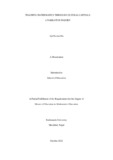
Please use this identifier to cite or link to this item:
https://hdl.handle.net/20.500.14301/104| Title: | TEACHING MATHEMATICS THROUGH CULTURAL CAPITALS: A NARRATIVE INQUIRY |
| Authors: | Jha, Ajit Kumar |
| Citation: | Jha, A.K. (2022).Teaching Mathematics Through Cultural Capital: A Narrative Inquiry. [Unpublished thesis], Kathmandu University. |
| Issue Date: | 19-Oct-2022 |
| Publisher: | School of Education |
| School: | SOED |
| Department: | DOSE |
| Level: | Masters |
| Abstract: | The purpose of this study was to explore the possible cultural capitals and examine how such cultural capitals enhance meaningful teaching and learning of mathematics. To accomplish this purpose, I adopted narrative inquiry as a research methodology. The formal and informal interaction/interviews with four different secondary mathematics teachers adopting cultural capital in their classroom and their experiences/stories were the major sources of data in this study. The collected data were coded, categorized, thematized, and analyzed with supportive literature. The experiences of the teachers were analyzed under different themes like mathematics curriculum and our practices, contextualization of mathematical concepts and their impact, ethno-mathematics, and ethno-culture, culture as an integral phenomenon in mathematics learning, and difficulty in addressing mathematics through cultural capitals. From this discussion on the collected data, this study concluded that curriculum is content loaded and it is difficult to cover the course in time. In this situation, integrating cultural capital might be a nightmare for some teachers but for conceptual understanding and long-lasting knowledge, cultural integration is necessary for mathematics teaching and learning. Integration of cultural capital in mathematics classroom practices not only makes the classrooms lively but can give authentic learning through real-world experiences. A teacher needs to be wise enough to address the learners’ interest in learning and integrate that cultural perspective into the mathematics classroom. It is clear that without learners’ motivation and interest, it is very difficult for a teacher to engage them in the learning process and get the desired outputs. The integration of cultural capital in mathematics classrooms can give real-life experiences of the learning phenomena and promotes experiential learning. Mathematics is everywhere in the environment, community, and around us, but we as a teacher fail to connect them to our learning process. This is because the majority of the teachers are still guided by the traditional way of teaching-learning perspective, where lecture methods and teacher-centered pedagogy are highly dominant. The one-size-fits-all approach and textbooks are the ultimate source of knowledge are other factors which make mathematics more abstract and less interesting for school students. Mathematics cannot be isolated from society and the context of the learner, and cultural integration in the classroom helps to contextualize the abstract concept and helps learners to build their understanding from real-world practices. Finally, the integration of cultural capital in mathematics teaching and learning can build a learner from a holistic development in every possible aspect. The findings and results of this study are possibly fruitful for teachers, teacher educators, and policymakers who want to integrate cultural capital as a pedagogical tool in the mathematics classroom. |
| URI: | http://101.251.6.110:8080/handle/20.500.14301/104 |
| Appears in Collections: | Research Project |
Files in This Item:
| File | Description | Size | Format | |
|---|---|---|---|---|
| Ajit Kumar Jha, MED in Maths Final thesis.pdf | 842.7 kB | Adobe PDF |  View/Open |
Items in DSpace are protected by copyright, with all rights reserved, unless otherwise indicated.